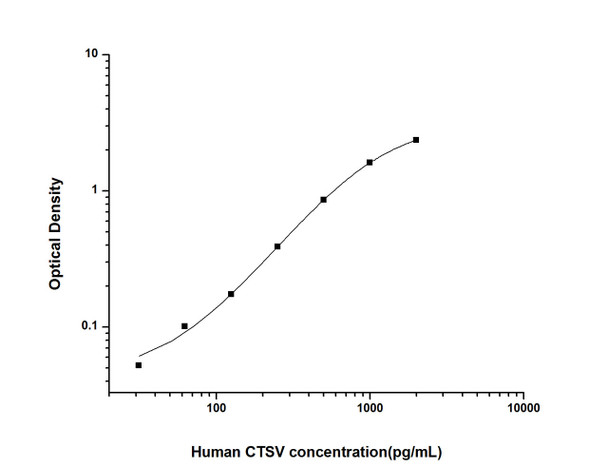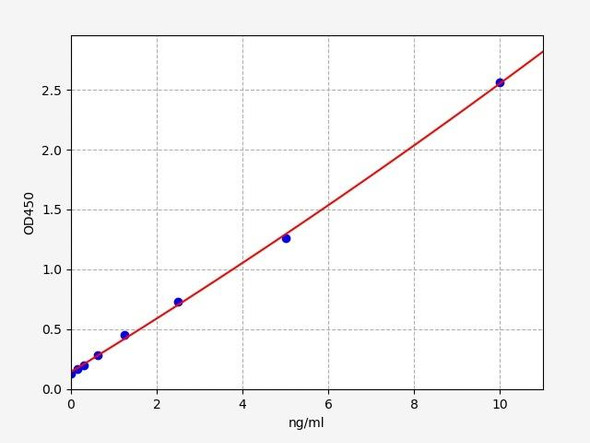Human CTSV (Cathepsin V) ELISA Kit (HUES01306)
- SKU:
- HUES01306
- Product Type:
- ELISA Kit
- Size:
- 96 Assays
- Uniprot:
- O60911
- Sensitivity:
- 18.75pg/mL
- Range:
- 31.25-2000pg/mL
- ELISA Type:
- Sandwich
- Synonyms:
- CTSL2, CATL2, CTSU
- Reactivity:
- Human
- Sample Type:
- Serum, plasma and other biological fluids
- Research Area:
- Cell Biology
Description
Human CTSV (Cathepsin V) ELISA Kit
The Human CTSV (Cathepsin V) ELISA Kit is a highly sensitive and specific assay designed for the accurate detection of Cathepsin V levels in human serum, plasma, and cell culture supernatants. This kit provides reliable and reproducible results, making it an ideal tool for researchers in various fields.Cathepsin V is an important enzyme involved in various physiological and pathological processes, including immunological responses, tissue remodeling, and cancer progression.
Elevated Cathepsin V levels have been associated with certain diseases, making it a valuable biomarker for studying these conditions and developing potential therapeutic interventions.With its advanced technology and user-friendly design, the Human CTSV ELISA Kit from Assay Genie is a valuable tool for researchers looking to study the role of Cathepsin V in health and disease. Get accurate and reliable results with this high-quality ELISA kit.
| Assay type: | Sandwich |
| Format: | 96T |
| Assay time: | 4.5h |
| Reactivity: | Human |
| Detection Method: | Colormetric |
| Detection Range: | 31.25-2000 pg/mL |
| Sensitivity: | 18.75 pg/mL |
| Sample Volume Required Per Well: | 100µL |
| Sample Type: | Serum, plasma and other biological fluids |
| Specificity: | This kit recognizes Human CTSV in samples. No significant cross-reactivity or interference between Human CTSV and analogues was observed. |
This ELISA kit uses Sandwich-ELISA as the method. The micro ELISA plate provided in this kit has been pre-coated with an antibody specific to Human CTSV. Standards or samples are added to the appropriate micro ELISA plate wells and combined with the specific antibody. Then a biotinylated detection antibody specific for Human CTSV and Avidin-Horseradish Peroxidase (HRP) conjugate are added to each micro plate well successively and incubated. Free components are washed away. The substrate solution is added to each well. Only those wells that contain Human CTSV, biotinylated detection antibody and Avidin-HRP conjugate will appear blue in color. The enzyme-substrate reaction is terminated by adding Stop Solution and the color turns yellow. The optical density (OD) is measured spectrophotometrically at a wavelength of 450 nm ± 2 nm. The OD value is proportional to the concentration of Human CTSV. The concentration of Human CTSV in samples can be calculated by comparing the OD of the samples to the standard curve.
| UniProt Protein Function: | CTSL2: Cysteine protease. May have an important role in corneal physiology. Belongs to the peptidase C1 family. |
| UniProt Protein Details: | Protein type:Secreted; Secreted, signal peptide; EC 3. 4. 22. 15; Protease Chromosomal Location of Human Ortholog: 9q22. 2 Cellular Component: extracellular space; lysosomal lumen; neuron projection; microvillus; apical part of cell; extracellular region; nucleolus; perikaryon; external side of plasma membrane; secretory granule Molecular Function:protein binding; histone binding; cysteine-type endopeptidase activity; protein complex binding; aminopeptidase activity; cysteine-type carboxypeptidase activity; kininogen binding; peptide binding; cysteine-type peptidase activity Biological Process: extracellular matrix organization and biogenesis; hair follicle morphogenesis; response to glucocorticoid stimulus; Sertoli cell differentiation; antigen processing and presentation of exogenous peptide antigen via MHC class II; multicellular organismal aging; decidualization; proteolysis; cellular response to starvation; extracellular matrix disassembly; protein autoprocessing; response to glucose stimulus; autophagic cell death; spermatogenesis; nerve development |
| NCBI Summary: | The protein encoded by this gene, a member of the peptidase C1 family, is a lysosomal cysteine proteinase that may play an important role in corneal physiology. This gene is expressed in colorectal and breast carcinomas but not in normal colon, mammary gland, or peritumoral tissues, suggesting a possible role for this gene in tumor processes. Alternatively spliced variants, encoding the same protein, have been identified. [provided by RefSeq, Jan 2011] |
| UniProt Code: | O60911 |
| NCBI GenInfo Identifier: | 12644075 |
| NCBI Gene ID: | 1515 |
| NCBI Accession: | O60911. 2 |
| UniProt Secondary Accession: | O60911,O60233, Q2TB86, Q5T1U0, |
| UniProt Related Accession: | O60911 |
| Molecular Weight: | 334 |
| NCBI Full Name: | Cathepsin L2 |
| NCBI Synonym Full Names: | cathepsin V |
| NCBI Official Symbol: | CTSV |
| NCBI Official Synonym Symbols: | CTSU; CATL2; CTSL2 |
| NCBI Protein Information: | cathepsin L2; cathepsin U; cathepsin L2, preproprotein |
| UniProt Protein Name: | Cathepsin L2 |
| UniProt Synonym Protein Names: | Cathepsin U; Cathepsin V |
| UniProt Gene Name: | CTSV |
| UniProt Entry Name: | CATL2_HUMAN |
As the OD values of the standard curve may vary according to the conditions of the actual assay performance (e. g. operator, pipetting technique, washing technique or temperature effects), the operator should establish a standard curve for each test. Typical standard curve and data is provided below for reference only.
| Concentration (pg/mL) | O.D | Average | Corrected |
| 2000 | 2.389 2.439 | 2.414 | 2.356 |
| 1000 | 1.654 1.688 | 1.671 | 1.613 |
| 500 | 0.927 0.903 | 0.915 | 0.857 |
| 250 | 0.446 0.448 | 0.447 | 0.389 |
| 125 | 0.24 0.224 | 0.232 | 0.174 |
| 62.5 | 0.172 0.146 | 0.159 | 0.101 |
| 31.25 | 0.11 0.11 | 0.11 | 0.052 |
| 0 | 0.049 0.067 | 0.058 | -- |
Precision
Intra-assay Precision (Precision within an assay): 3 samples with low, mid range and high level Human CTSV were tested 20 times on one plate, respectively.
Inter-assay Precision (Precision between assays): 3 samples with low, mid range and high level Human CTSV were tested on 3 different plates, 20 replicates in each plate.
| Intra-assay Precision | Inter-assay Precision | |||||
| Sample | 1 | 2 | 3 | 1 | 2 | 3 |
| n | 20 | 20 | 20 | 20 | 20 | 20 |
| Mean (pg/mL) | 99.29 | 221.49 | 925.72 | 104.33 | 212.78 | 855.46 |
| Standard deviation | 6.02 | 10.85 | 34.90 | 6.62 | 9.85 | 26.78 |
| C V (%) | 6.06 | 4.90 | 3.77 | 6.35 | 4.63 | 3.13 |
Recovery
The recovery of Human CTSV spiked at three different levels in samples throughout the range of the assay was evaluated in various matrices.
| Sample Type | Range (%) | Average Recovery (%) |
| Serum (n=5) | 84-98 | 90 |
| EDTA plasma (n=5) | 91-102 | 97 |
| Cell culture media (n=5) | 96-109 | 102 |
Linearity
Samples were spiked with high concentrations of Human CTSV and diluted with Reference Standard & Sample Diluent to produce samples with values within the range of the assay.
| Serum (n=5) | EDTA plasma (n=5) | Cell culture media (n=5) | ||
| 1:2 | Range (%) | 86-99 | 99-115 | 93-108 |
| Average (%) | 92 | 105 | 99 | |
| 1:4 | Range (%) | 88-102 | 82-94 | 88-103 |
| Average (%) | 93 | 87 | 94 | |
| 1:8 | Range (%) | 90-103 | 82-97 | 88-99 |
| Average (%) | 97 | 88 | 93 | |
| 1:16 | Range (%) | 85-98 | 83-95 | 83-96 |
| Average (%) | 92 | 89 | 90 |
An unopened kit can be stored at 4°C for 1 month. If the kit is not used within 1 month, store the items separately according to the following conditions once the kit is received.
| Item | Specifications | Storage |
| Micro ELISA Plate(Dismountable) | 8 wells ×12 strips | -20°C, 6 months |
| Reference Standard | 2 vials | |
| Concentrated Biotinylated Detection Ab (100×) | 1 vial, 120 µL | |
| Concentrated HRP Conjugate (100×) | 1 vial, 120 µL | -20°C(shading light), 6 months |
| Reference Standard & Sample Diluent | 1 vial, 20 mL | 4°C, 6 months |
| Biotinylated Detection Ab Diluent | 1 vial, 14 mL | |
| HRP Conjugate Diluent | 1 vial, 14 mL | |
| Concentrated Wash Buffer (25×) | 1 vial, 30 mL | |
| Substrate Reagent | 1 vial, 10 mL | 4°C(shading light) |
| Stop Solution | 1 vial, 10 mL | 4°C |
| Plate Sealer | 5 pieces | |
| Product Description | 1 copy | |
| Certificate of Analysis | 1 copy |
- Set standard, test sample and control (zero) wells on the pre-coated plate and record theirpositions. It is recommended to measure each standard and sample in duplicate. Note: addall solutions to the bottom of the plate wells while avoiding contact with the well walls. Ensuresolutions do not foam when adding to the wells.
- Aliquot 100 µL of standard solutions into the standard wells.
- Add 100 µL of Sample / Standard dilution buffer into the control (zero) well.
- Add 100 µL of properly diluted sample (serum, plasma, tissue homogenates and otherbiological fluids) into test sample wells.
- Cover the plate with the sealer provided in the kit and incubate for 90 min at 37 °C.
- Aspirate the liquid from each well, do not wash. Immediately add 100 µL of BiotinylatedDetection Ab working solution to each well. Cover the plate with a plate seal and gently mix. Incubate for 1 hour at 37 °C.
- Aspirate or decant the solution from the plate and add 350 µL of wash buffer to each welland incubate for 1-2 minutes at room temperature. Aspirate the solution from each well andclap the plate on absorbent filter paper to dry. Repeat this process 3 times. Note: a microplatewasher can be used in this step and other wash steps.
- Add 100 µL of HRP Conjugate working solution to each well. Cover with a plate seal andincubate for 30 min at 37 °C.
- Aspirate or decant the solution from each well. Repeat the wash process for five times asconducted in step 7.
- Add 90 µL of Substrate Reagent to each well. Cover with a new plate seal and incubate forapproximately 15 min at 37 °C. Protect the plate from light. Note: the reaction time can beshortened or extended according to the actual color change, but not by more than 30min.
- Add 50 µL of Stop Solution to each well. Note: Adding the stop solution should be done inthe same order as the substrate solution.
- Determine the optical density (OD value) of each well immediately with a microplate readerset at 450 nm.








